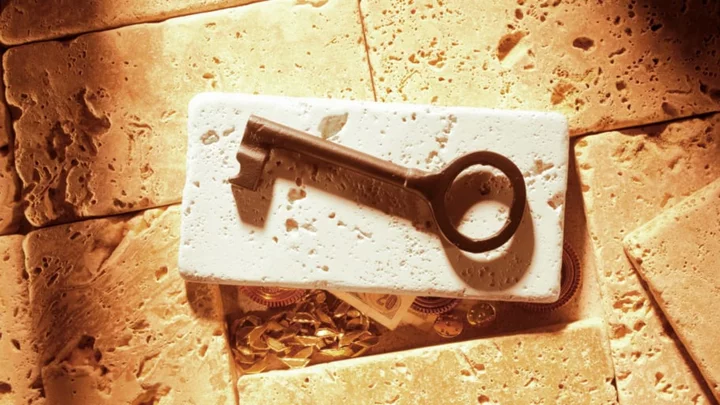At first, Milton Noss thought a rattlesnake was crawling up his leg. It was November 1937, and Noss, 32, was staking out a mountain top in the arid, dry heat of New Mexico in the hopes of catching a deer headed for the spring water nearby.
But when Noss looked down, there was no snake. There was only a faint breeze drifting up from the ground. Upon closer inspection, he discovered a hole under a rock—and not just a hole, but one already equipped with a ladder.
The find naturally piqued Noss’s curiosity. He later returned to the site equipped with rope and a flashlight and went spelunking, lowering himself into what turned out to be an immense network of caverns hidden inside the mountain known as Victorio Peak.
What happened next was out of a movie: Noss said he found a cave with skeletons, Wells Fargo chests, antique armor, and jewels. Later, he pulled out what he thought to be cheap iron bars. They turned out to be gold—roughly 16,000 of them. In today’s dollars, Noss found a treasure that could be valued as much as $28 billion.
But instead of generational wealth, Noss uncovered generational heartache. His life would be consumed by attempts to retrieve the stash, with everyone from the U.S. Army to gun-wielding enemies standing in his way. It’s a tale that’s thrilled treasure seekers for nearly a century, with one central question still outstanding: Will anyone ever be able to fully retrace his steps and claim the massive trove? And after all this time, is there anything left to plunder?
A Golden Opportunity
Victorio Peak—which was named after the 19th century Mescalero Apache warrior chief—is a formidable summit rising 6350 feet above sea level in the San Andres Mountains in New Mexico. Today, it’s part of the White Sands Missile Range, a huge swath of property leased from the state by the United States Army that once hosted the first atomic bomb detonation in 1945. But when Noss first encountered the peak, it was something far simpler: A veritable goldmine.
Noss, nicknamed “Doc,” was a self-taught podiatrist who tended to bunions and ingrown toenails in the town now known as Truth or Consequences. (The town, which was called Hot Springs, agreed to change its name as part of a Truth or Consequences game show promotion in 1950.) He had been married since 1933 to Ova Beckwith, who was predictably astonished at her husband’s discovery. Ova and her children from a previous marriage helped Noss heave sacks of treasure away from the peak. It was Ova, in fact, who had seen the iron bars for what they really were—gold.
“I asked him to bring out some of that pig iron he was talking about and he said it was too heavy,” Ova later recalled in the 1970s. “But he found a small one and brought it out and said, ‘That’s the last one of them babies I’m gonna bring out.’ When I rolled it over, I said, ‘Well, Doc, this is yellow! Look at it!’ He looked at it and said, ‘Well, Babe, if that’s gold and all that other is gold, we can call John D. Rockefeller a tramp!’”
But Doc and Ova couldn’t boast about anything just yet. Thanks to the Gold Reserve Act of 1934, it was illegal for private citizens to possess gold. (The Act was signed into law by President Franklin D. Roosevelt in an effort to boost government gold reserves and bounce back from the Great Depression.) Even if owning the gold bars hadn’t been illegal, it would be laborious to move them from the bowels of the peak, particularly given the tight squeeze Noss had to enter and exit through.
(One problem Noss didn’t need to worry about was having to answer to the treasure’s original owners. Though he may not have been aware at the time, speculation has had it that the stash could have been Aztec treasure, the work of an 18th century gold miner, or even loot taken by Apache tribes raiding stagecoaches from California.)
Initially, Noss concerned himself with dealing with state bureaucracy. In 1938, he filed to lease the property from New Mexico and also obtained a treasure trove claim. (In cases of discovered treasure, the person who found it typically has a legally valid claim to it, with the sole exception of the “true” or original owner, if one can be demonstrated.) Next, he began to systematically trudge the gold bars out from the cavern, though the tunnel network, and out to daylight, where he then began to burrow them away in various hiding spots. Accounts vary, but Noss could have retrieved 200 gold bars.
Then disaster struck—or, more accurately, Noss himself struck. In 1939, he hired a mining engineer to create a larger entrance to the peak. In irony reminiscent of a Looney Tunes short, Noss and his companion wound up using too much dynamite, blowing the entrance up and sealing off the vertical network of tunnels that Noss had used to access the cave.
With entry curtailed for the foreseeable future, Noss turned instead to selling what gold he had managed to squirrel away, often in nugget-sized pieces to avoid the wrath of law enforcement. At one point, he seemed to grow tired of the entire affair, moving to Texas without Ova for a period of time. When he returned, he had a new wife named Violet and a new business partner: Charley Ryan. In 1949, Noss convinced Ryan to invest a total of $28,000 in the hopes of regaining access to the cave. Noss also promised to sell Ryan 50 bars of gold.
The night before the deal for the gold was to go down, Noss seemed to panic. An associate named Tony Jolley later claimed he helped Noss re-bury 110 bars, presumably so they couldn’t be located by Ryan.
The next day, Noss and Ryan’s business relationship came to an end. Ryan seemed to be unhappy with Noss failing to deliver on his promises. They got into an altercation, and as Noss jogged away, Ryan produced a handgun and shot him in the back of the head. Noss died against the bumper of his truck. He was 43.
In criminal proceedings, Ryan claimed Noss was running back to his truck for a weapon; a jury believed him, and Ryan was acquitted. But the legend of Victorio Peak wouldn’t die with Noss. If anything, it would only get stronger.
A Military Presence
Ova was determined to continue the search that her estranged (and now late) husband had started. But there was a new wrinkle—one that would turn the hunt from a family affair to a political entanglement. The United States military had already established the White Sands Missile Range for weapons testing in 1945. In 1955, it extended its bounds to include Victorio Peak. Now under control of the government, the premises were off-limits to civilians like Ova.
But some in the military were intrigued by the Noss legend. In 1958, four officers from nearby Holloman Air Force Base, including a man named Thomas Berlett, began exploring Victorio Peak. Months of searching led to the discovery of gold bars within the mountain.
“We saw artifacts on the wall; one was a very large cross, made up of smaller crosses, all carved of wood,'” Berlett said in 1991. “There were two stacks of gold in the first room ... [one man] could lay in the tunnel and see into the next room with a flashlight. The stack of gold in that room was in the shape of a pyramid, and we could see an exit out of the room ... We believe that it probably led into the main chamber that had been described in the diaries of Doc Noss.”
The men reported the find to their superior officers and requested a formal military expedition into the cave. When that request was refused, they rigged another dynamite explosion, this one sealing off the cave entrance. If they weren’t able to pursue the treasure, they didn’t want others to intervene. Later, in 1961, the men passed a military polygraph test to demonstrate the veracity of their claims. They were permitted to return, but couldn’t find another way in. Berlett would later speculate that the military allowed him back to the site to try and pinpoint where he and the other officers had first gained access.
Rumors grew in the following years that the Army, informed of the treasure, secretly began removing it from the cave. While some eyewitnesses have claimed to have seen Army activity on the peak, the Army denied confiscating any gold. The story gained more traction when a man named Gene Erwin claimed his brother-in-law, Captain Orby Swanner, told him he led a military operation to fetch the gold around this time and that he had even written his name and serial number on one of the cave walls.
Ova Noss and her family were predictably livid about the Army activity and the stories surrounding retrieved gold. She petitioned for the state of New Mexico to intervene; they ordered Army activity into the peak be stopped in 1961, though not in time to stop Swanner’s alleged expedition. Ova was then allowed to conduct a 60-day search in 1963. She hired a mining company but nothing was found. The massive peak and its reputed tunnels were like a giant ant farm; burrowing into them took time, money, and more than a bit of luck.
With most everyone left out in the cold, a strange bit of testimony during the Watergate hearings in 1973 made the treasure a matter of public knowledge. John Dean, formerly a lawyer for Richard Nixon, said that he had heard from Attorney General John Mitchell that Mitchell had been told about someone who wanted to turn over the gold without facing legal repercussions. Soon after, famed attorney F. Lee Bailey—who would later be part of O.J. Simpson’s defense team—said he was representing roughly 50 clients who knew the exact location of the gold. Bailey was hoping to obtain Army permission to visit the site and to discern whether his clients had legal right to the bars. (The Gold Reserve Act was due to be rescinded at the end of 1974, making their possession legal.) But the Army wanted him to divulge the names of his clients as well as the gold’s precise location in advance, which Bailey refused to do.
Some believed those involved were former members of the military; other speculation had it that Bailey’s group included a geologist named Keith Alexander, who learned of the gold through an old associate of Noss’s named Benny Samaniego. Bailey even had a bar submitted for analysis by the Treasury Department, which found it to be 60 percent gold. This lead seemed to evaporate, however, as Bailey’s clients never stepped out of the shadows.
The publicity from the Watergate hearings and Bailey was enough to stir interest in the site from treasure seekers. The Army began posting 24-hour armed security and cautioned that the site was too dangerous for visits. Radiation and scorpions were among the hazards. But Ova was not easily dissuaded. As the number of claimants grew, she sought to reassert her family’s own claim to the still-hypothetical treasure.
A Family Ambition
In the spring of 1977, a professional treasure hunter named Norman Scott organized a search on behalf of those who felt they had a valid claim to the treasure, including one of the Air Force officers and a representative from the Apache nation. Ova, whose family had long held the original claim, was there, as well. A 10-day search window was granted by the Army, who seemed to want to dispense with the controversy as well as discourage any further trespassing. Scott invested $75,000.
Despite being granted three additional days, Scott only found some empty tin cans, a pair of dirty pants, and a tiny nugget that might have contained a tenth of 1 percent gold. The most compelling discovery was the scrawled name of Orby Swanner, the Army captain who once told his family he had led a mission to retrieve the gold. His name and serial number were written on the wall, just as Swanner had once claimed.
As Ova aged—she would pass in 1979—her family increasingly took up the cause. Her grandson, Terry Delonas, had grown up hearing stories of the treasure, the tragedy of Doc Noss’s death, and the Army’s stubborn refusal to allow access. Throughout the 1980s, Delonas asked—and kept asking—for another chance to explore the peak.
The Army threw a curveball. Delonas could come, they said, providing he got permission from Congress. If this was intended to dissuade Delonas, it didn’t work: He befriended Congressional Representative Joe Skeen, who worked to include a rider in 1990’s Defense Authorization Bill. Delonas and the Ova Noss Family Partnership would again be allowed access to the peak. If anything was found, cultural artifacts would be turned over to New Mexico. Valuables, like the gold, would be held until a federal court could decide on who had the rightful claim.
From 1992 to 1996, Delonas helped lead a search with experts in mining, geology, and construction, heaving massive mounds of dirt and exploring the various entrances into the peak. The project was estimated to cost up to $2 million.
Even with resources, the sheer size and scope of the peak made exploration difficult. Though a geological survey indicated a void in the mountain roughly where Doc Noss had insisted the cave was, there was no easy route to it. The team moved slowly through dirt and rock, at times being rerouted when unpredictable collapses sealed off further entry.
In March 1996, Delonas felt progress was being made. Using survey data, they felt they were just 20 feet from a cave that could in theory contain the treasure—or at least what was left of it. Then, the Army began raising issues over the monthly fees they were collecting from Delonas for access to the site. The bickering led to Delonas being refused entry, which led to Delonas filing a lawsuit and the Army a countersuit for what they claimed were unpaid fees of $700,000 and abandoned equipment on the peak.
In 2000, both sides dropped the suits, with the Army forgiving the alleged debt if Delonas agreed not to pursue any further permission for access. Delonas believed the Army was still being less than forthcoming, but there was little else to do: While it’s possible the treasure could have been within reach, four years of work had failed to yield tangible discovery of even one cavern.
There’s no record of Delonas or any private citizen being allowed to return to Victorio Peak after his team’s exit in 1996. Following the airing of the 2023 documentary series, Discovery ID’s Gold, Lies & Videotape, a Change.org petition was launched to champion Delonas being given more access to the site. At the time this piece was published, the petition had roughly half of the 1000 signatures targeted as its goal. (While the U.S. government has no requirement to respond, the petition may raise awareness for his cause.)
Some are skeptical of Noss’s original claim, citing his peddling of fake gold bars and story of a cave-in as hints he may have merely tried to swindle investors out of money. But the insistence of everyone from military members to colleagues that they had seen gold is hard to discount. Tony Jolley, who helped Noss bury his stash before Noss was killed in 1949, once said he returned to some of the hiding spots in 1961, collecting $66,000 in gold. And there was Orby Swanner, who seemingly signed his confession on a cave wall. Billions could still be deep inside Victorio Peak, effectively entombed until the Noss family or other treasure seekers manage to blast their way through both rock and government bureaucracy.
As one observer put it as a search was underway in 1997: “Gold legends do not die easily.”
This article was originally published on www.mentalfloss.com as The Enduring Enigma of the Victorio Peak Treasure.









